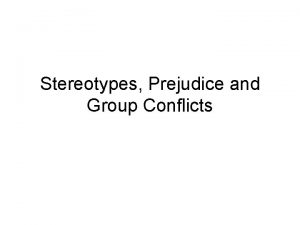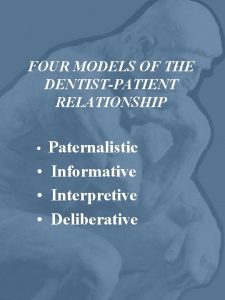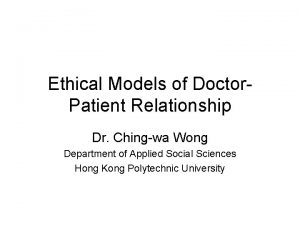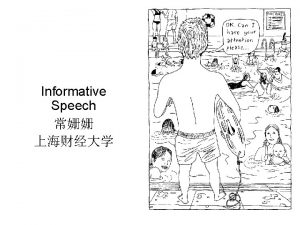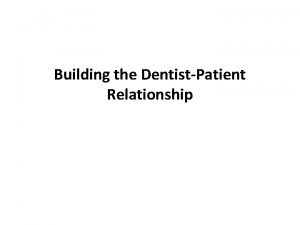FOUR MODELS OF THE DENTISTPATIENT RELATIONSHIP Paternalistic Informative





- Slides: 5

FOUR MODELS OF THE DENTIST-PATIENT RELATIONSHIP Paternalistic • Informative • Interpretive • Deliberative •

PATERNALISTIC MODEL (Priestly, Parental) • Dentist interacts with patient in much the same way a parent would relate to a child. • Little or no role for patient autonomy; dentist assumes role of deciding for the patient. • Conception of patient autonomy is that patient assents to dentist’s determination of what is best. • Selected information provided that will encourage patient to consent to intervention dentist considers best. • Dentist has the FACTS of the case and uses his/her VALUES to determine what is best for the patient. • Acts as patient guardian.

INFORMATIVE MODEL (Scientific, Engineering, Consumer) • Objective of interaction is for dentist to provide patient with all relevant information and for the patient to select the interventions he or she wants, with dentist executing desired therapy. • Model assumes clear distinction between FACTS and VALUES. Patient’s VALUES are known but patient lacks FACTS. Dentist provides the FACTS of the case, and patient’s VALUES determine the treatment to be rendered. There is no role for dentist’s VALUES. • Dentist is purveyor of clinical knowledge and technical expertise. • Conception of patient autonomy is patient is in complete control over decision making.

INTERPRETIVE MODEL • Aim of dentist - patient interaction is to elucidate the patient’s VALUES and to help the patient select the available therapies that realize these VALUES. • While providing information, the dentist also assists the patient in elucidating, understanding, and articulating values. Model assumes patient’s VALUES are not necessarily fixed or known. • Dentist does not dictate; it is the patient who ultimately decides which VALUES and course of action best fit • Dentist as counselor; engaging patient in joint process of understanding. • Conception of patient autonomy is selfunderstanding by the patient.

DELIBERATIVE MODEL • Aim is to help patient determine and chose best health-related VALUES that can be realized in the clinical situation. • Dentist discusses relevant FACTS regarding the patient’s clinical situation and helps elucidate types of VALUES embodied in available options. Dentist suggests why certain health-related values are more worthy and should be aspired to. • Dentist’s actions/expression of desirable VALUES are no more than persuasive --psychological coercion is avoided. • Dentist as teacher (doctor)/friend/partiner. • Conception of patient autonomy is moral selfdevelopment; patient empowered to consider, through dialogue, alternative health-related VALUES their worthiness, and their implications for treatment given relevant FACTS.

